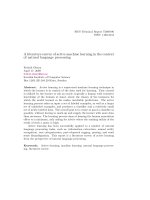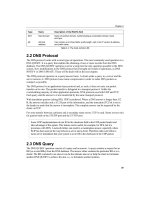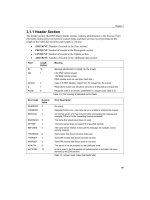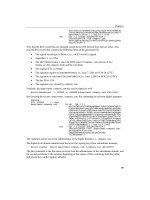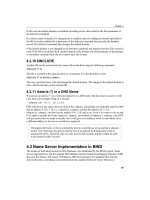machine learning in action
Bạn đang xem bản rút gọn của tài liệu. Xem và tải ngay bản đầy đủ của tài liệu tại đây (8.51 MB, 382 trang )
MANNING
Peter Harrington
IN ACTION
Machine Learning in ActionMachine Learning in Action
PETER HARRINGTON
MANNING
Shelter Island
For online information and ordering of this and other Manning books, please visit
www.manning.com. The publisher offers discounts on this book when ordered in quantity.
For more information, please contact
Special Sales Department
Manning Publications Co.
20 Baldwin Road
PO Box 261
Shelter Island, NY 11964
Email:
©2012 by Manning Publications Co. All rights reserved.
No part of this publication may be reproduced, stored in a retrieval system, or transmitted, in
any form or by means electronic, mechanical, photocopying, or otherwise, without prior written
permission of the publisher.
Many of the designations used by manufacturers and sellers to distinguish their products are
claimed as trademarks. Where those designations appear in the book, and Manning
Publications was aware of a trademark claim, the designations have been printed in initial caps
or all caps.
Recognizing the importance of preserving what has been written, it is Manning’s policy to have
the books we publish printed on acid-free paper, and we exert our best efforts to that end.
Recognizing also our responsibility to conserve the resources of our planet, Manning books are
printed on paper that is at least 15 percent recycled and processed without the use of elemental
chlorine.
Manning Publications Co.Development editor:Jeff Bleiel
20 Baldwin Road Technical proofreaders: Tricia Hoffman, Alex Ott
PO Box 261 Copyeditor: Linda Recktenwald
Shelter Island, NY 11964 Proofreader: Maureen Spencer
Typesetter: Gordan Salinovic
Cover designer: Marija Tudor
ISBN 9781617290183
Printed in the United States of America
1 2 3 4 5 6 7 8 9 10 – MAL – 17 16 15 14 13 12
To Joseph and Milo
brief contents
PART 1 CLASSIFICATION 1
1 ■ Machine learning basics 3
2 ■ Classifying with k-Nearest Neighbors 18
3 ■ Splitting datasets one feature at a time: decision trees 37
4 ■ Classifying with probability theory: naïve Bayes 61
5 ■ Logistic regression 83
6 ■ Support vector machines 101
7 ■ Improving classification with the AdaBoost
meta-algorithm 129
PART 2 FORECASTING NUMERIC VALUES WITH REGRESSION 151
8 ■ Predicting numeric values: regression 153
9 ■ Tree-based regression 179
PART 3 UNSUPERVISED LEARNING 205
10 ■ Grouping unlabeled items using k-means clustering 207
11 ■ Association analysis with the Apriori algorithm 224
12 ■ Efficiently finding frequent itemsets with FP-growth 248
BRIEF CONTENTS
viii
PART 4 ADDITIONAL TOOLS 267
13 ■ Using principal component analysis to simplify data 269
14 ■ Simplifying data with the singular value
decomposition 280
15 ■ Big data and MapReduce 299
ix
contents
preface xvii
acknowledgments xix
about this book xxi
about the author xxv
about the cover illustration xxvi
PART 1 CLASSIFICATION 1
1
Machine learning basics 3
1.1 What is machine learning? 5
Sensors and the data deluge 6
■
Machine learning will be more
important in the future 7
1.2 Key terminology 7
1.3 Key tasks of machine learning 10
1.4 How to choose the right algorithm 11
1.5 Steps in developing a machine learning application 11
1.6 Why Python? 13
Executable pseudo-code 13
■
Python is popular 13
■
What
Python has that other languages don’t have 14
■
Drawbacks 14
1.7 Getting started with the NumPy library 15
1.8 Summary 17
CONTENTS
x
2
Classifying with k-Nearest Neighbors 18
2.1 Classifying with distance measurements 19
Prepare: importing data with Python 21
■
Putting the kNN classification
algorithm into action 23
■
How to test a classifier 24
2.2 Example: improving matches from a dating site with kNN 24
Prepare: parsing data from a text file 25
■
Analyze: creating scatter plots
with Matplotlib 27
■
Prepare: normalizing numeric values 29
■
Test:
testing the classifier as a whole program 31
■
Use: putting together a
useful system 32
2.3 Example: a handwriting recognition system 33
Prepare: converting images into test vectors 33
■
Test: kNN on
handwritten digits 35
2.4 Summary 36
3
Splitting datasets one feature at a time: decision trees 37
3.1 Tree construction 39
Information gain 40
■
Splitting the dataset 43
■
Recursively
building the tree 46
3.2 Plotting trees in Python with Matplotlib annotations 48
Matplotlib annotations 49
■
Constructing a tree of annotations 51
3.3 Testing and storing the classifier 56
Test: using the tree for classification 56
■
Use: persisting the
decision tree 57
3.4 Example: using decision trees to predict contact lens type 57
3.5 Summary 59
4
Classifying with probability theory: naïve Bayes 61
4.1 Classifying with Bayesian decision theory 62
4.2 Conditional probability 63
4.3 Classifying with conditional probabilities 65
4.4 Document classification with naïve Bayes 65
4.5 Classifying text with Python 67
Prepare: making word vectors from text 67
■
Train: calculating
probabilities from word vectors 69
■
Test: modifying the classifier for real-
world conditions 71
■
Prepare: the bag-of-words document model 73
4.6 Example: classifying spam email with naïve Bayes 74
Prepare: tokenizing text 74
■
Test: cross validation with naïve Bayes 75
CONTENTS
xi
4.7 Example: using naïve Bayes to reveal local attitudes from
personal ads 77
Collect: importing RSS feeds 78
■
Analyze: displaying locally used
words 80
4.8 Summary 82
5
Logistic regression 83
5.1 Classification with logistic regression and the sigmoid
function: a tractable step function 84
5.2 Using optimization to find the best regression coefficients 86
Gradient ascent 86
■
Train: using gradient ascent to find the best
parameters 88
■
Analyze: plotting the decision boundary 90
Train: stochastic gradient ascent 91
5.3 Example: estimating horse fatalities from colic 96
Prepare: dealing with missing values in the data 97
■
Test:
classifying with logistic regression 98
5.4 Summary 100
6
Support vector machines 101
6.1 Separating data with the maximum margin 102
6.2 Finding the maximum margin 104
Framing the optimization problem in terms of our classifier 104
Approaching SVMs with our general framework 106
6.3 Efficient optimization with the SMO algorithm 106
Platt’s SMO algorithm 106
■
Solving small datasets with the
simplified SMO 107
6.4 Speeding up optimization with the full Platt SMO 112
6.5 Using kernels for more complex data 118
Mapping data to higher dimensions with kernels 118
■
The radial
bias function as a kernel 119
■
Using a kernel for testing 122
6.6 Example: revisiting handwriting classification 125
6.7 Summary 127
7
Improving classification with the AdaBoost meta-algorithm 129
7.1 Classifiers using multiple samples of the dataset 130
Building classifiers from randomly resampled data: bagging 130
Boosting 131
7.2 Train: improving the classifier by focusing on errors 131
CONTENTS
xii
7.3 Creating a weak learner with a decision stump 133
7.4 Implementing the full AdaBoost algorithm 136
7.5 Test: classifying with AdaBoost 139
7.6 Example: AdaBoost on a difficult dataset 140
7.7 Classification imbalance 142
Alternative performance metrics: precision, recall, and ROC 143
Manipulating the classifier’s decision with a cost function 147
Data sampling for dealing with classification imbalance 148
7.8 Summary 148
PART 2 FORECASTING NUMERIC VALUES WITH REGRESSION .151
8
Predicting numeric values: regression 153
8.1 Finding best-fit lines with linear regression 154
8.2 Locally weighted linear regression 160
8.3 Example: predicting the age of an abalone 163
8.4 Shrinking coefficients to understand our data 164
Ridge regression 164
■
The lasso 167
■
Forward stagewise
regression 167
8.5 The bias/variance tradeoff 170
8.6 Example: forecasting the price of LEGO sets 172
Collect: using the Google shopping API 173
■
Train: building a model 174
8.7 Summary 177
9
Tree-based regression 179
9.1 Locally modeling complex data 180
9.2 Building trees with continuous and discrete features 181
9.3 Using CART for regression 184
Building the tree 184
■
Executing the code 186
9.4 Tree pruning 188
Prepruning 188
■
Postpruning 190
9.5 Model trees 192
9.6 Example: comparing tree methods to standard regression 195
9.7 Using Tkinter to create a GUI in Python 198
Building a GUI in Tkinter 199
■
Interfacing Matplotlib and Tkinter 201
9.8 Summary 203
CONTENTS
xiii
PART 3 UNSUPERVISED LEARNING 205
10
Grouping unlabeled items using k-means clustering 207
10.1 The k-means clustering algorithm 208
10.2 Improving cluster performance with postprocessing 213
10.3 Bisecting k-means 214
10.4 Example: clustering points on a map 217
The Yahoo! PlaceFinder API 218
■
Clustering geographic
coordinates 220
10.5 Summary 223
11
Association analysis with the Apriori algorithm 224
11.1 Association analysis 225
11.2 The Apriori principle 226
11.3 Finding frequent itemsets with the Apriori algorithm 228
Generating candidate itemsets 229
■
Putting together the full
Apriori algorithm 231
11.4 Mining association rules from frequent item sets 233
11.5 Example: uncovering patterns in congressional voting 237
Collect: build a transaction data set of congressional voting
records 238
■
Test: association rules from congressional voting
records 243
11.6 Example: finding similar features in poisonous
mushrooms 245
11.7 Summary 246
12
Efficiently finding frequent itemsets with FP-growth 248
12.1 FP-trees: an efficient way to encode a dataset 249
12.2 Build an FP-tree 251
Creating the FP-tree data structure 251
■
Constructing the FP-tree 252
12.3 Mining frequent items from an FP-tree 256
Extracting conditional pattern bases 257
■
Creating conditional
FP-trees 258
12.4 Example: finding co-occurring words in a Twitter feed 260
12.5 Example: mining a clickstream from a news site 264
12.6 Summary 265
CONTENTS
xiv
PART 4 ADDITIONAL TOOLS 267
13
Using principal component analysis to simplify data 269
13.1 Dimensionality reduction techniques 270
13.2 Principal component analysis 271
Moving the coordinate axes 271
■
Performing PCA in NumPy 273
13.3 Example: using PCA to reduce the dimensionality of
semiconductor manufacturing data 275
13.4 Summary 278
14
Simplifying data with the singular value decomposition 280
14.1 Applications of the SVD 281
Latent semantic indexing 281
■
Recommendation systems 282
14.2 Matrix factorization 283
14.3 SVD in Python 284
14.4 Collaborative filtering–based recommendation engines 286
Measuring similarity 287
■
Item-based or user-based similarity? 289
Evaluating recommendation engines 289
14.5 Example: a restaurant dish recommendation engine 290
Recommending untasted dishes 290
■
Improving recommendations with
the SVD 292
■
Challenges with building recommendation engines 295
14.6 Example: image compression with the SVD 295
14.7 Summary 298
15
Big data and MapReduce 299
15.1 MapReduce: a framework for distributed computing 300
15.2 Hadoop Streaming 302
Distributed mean and variance mapper 303
■
Distributed mean
and variance reducer 304
15.3 Running Hadoop jobs on Amazon Web Services 305
Services available on AWS 305
■
Getting started with Amazon
Web Services 306
■
Running a Hadoop job on EMR 307
15.4 Machine learning in MapReduce 312
15.5 Using mrjob to automate MapReduce in Python 313
Using mrjob for seamless integration with EMR 313
■
The anatomy of a
MapReduce script in mrjob 314
CONTENTS
xv
15.6 Example: the Pegasos algorithm for distributed SVMs 316
The Pegasos algorithm 317
■
Training: MapReduce support
vector machines with mrjob 318
15.7 Do you really need MapReduce? 322
15.8 Summary 323
appendix A Getting started with Python 325
appendix B Linear algebra 335
appendix C Probability refresher 341
appendix D Resources 345
index 347
preface
After college I went to work for Intel in California and mainland China. Originally my
plan was to go back to grad school after two years, but time flies when you are having
fun, and two years turned into six. I realized I had to go back at that point, and I
didn’t want to do night school or online learning, I wanted to sit on campus and soak
up everything a university has to offer. The best part of college is not the classes you
take or research you do, but the peripheral things: meeting people, going to seminars,
joining organizations, dropping in on classes, and learning what you don’t know.
Sometime in 2008 I was helping set up for a career fair. I began to talk to someone
from a large financial institution and they wanted me to interview for a position mod-
eling credit risk (figuring out if someone is going to pay off their loans or not). They
asked me how much stochastic calculus I knew. At the time, I wasn’t sure I knew what
the word stochastic meant. They were hiring for a geographic location my body
couldn’t tolerate, so I decided not to pursue it any further. But this stochastic stuff
interested me, so I went to the course catalog and looked for any class being offered
with the word “stochastic” in its title. The class I found was “Discrete-time Stochastic
Systems.” I started attending the class without registering, doing the homework and
taking tests. Eventually I was noticed by the professor and she was kind enough to let
me continue, for which I am very grateful. This class was the first time I saw probability
applied to an algorithm. I had seen algorithms take an averaged value as input before,
but this was different: the variance and mean were internal values in these algorithms.
The course was about “time series” data where every piece of data is a regularly spaced
sample. I found another course with Machine Learning in the title. In this class the
PREFACE
xviii
data was not assumed to be uniformly spaced in time, and they covered more algo-
rithms but with less rigor. I later realized that similar methods were also being taught
in the economics, electrical engineering, and computer science departments.
In early 2009, I graduated and moved to Silicon Valley to start work as a software
consultant. Over the next two years, I worked with eight companies on a very wide
range of technologies and saw two trends emerge which make up the major thesis for
this book: first, in order to develop a compelling application you need to do more
than just connect data sources; and second, employers want people who understand
theory and can also program.
A large portion of a programmer’s job can be compared to the concept of connect-
ing pipes—except that instead of pipes, programmers connect the flow of data—and
monstrous fortunes have been made doing exactly that. Let me give you an example.
You could make an application that sells things online—the big picture for this would
be allowing people a way to post things and to view what others have posted. To do this
you could create a web form that allows users to enter data about what they are selling
and then this data would be shipped off to a data store. In order for other users to see
what a user is selling, you would have to ship the data out of the data store and display
it appropriately. I’m sure people will continue to make money this way; however to
make the application really good you need to add a level of intelligence. This intelli-
gence could do things like automatically remove inappropriate postings, detect fraud-
ulent transactions, direct users to things they might like, and forecast site traffic. To
accomplish these objectives, you would need to apply machine learning. The end user
would not know that there is magic going on behind the scenes; to them your applica-
tion “just works,” which is the hallmark of a well-built product.
An organization may choose to hire a group of theoretical people, or “thinkers,”
and a set of practical people, “doers.” The thinkers may have spent a lot of time in aca-
demia, and their day-to-day job may be pulling ideas from papers and modeling them
with very high-level tools or mathematics. The doers interface with the real world by
writing the code and dealing with the imperfections of a non-ideal world, such as
machines that break down or noisy data. Separating thinkers from doers is a bad idea
and successful organizations realize this. (One of the tenets of lean manufacturing is
for the thinkers to get their hands dirty with actual doing.) When there is a limited
amount of money to be spent on hiring, who will get hired more readily—the thinker
or the doer? Probably the doer, but in reality employers want both. Things need to get
built, but when applications call for more demanding algorithms it is useful to have
someone who can read papers, pull out the idea, implement it in real code, and iterate.
I didn’t see a book that addressed the problem of bridging the gap between think-
ers and doers in the context of machine learning algorithms. The goal of this book is
to fill that void, and, along the way, to introduce uses of machine learning algorithms
so that the reader can build better applications.
xix
acknowledgments
This is by far the easiest part of the book to write
First, I would like to thank the folks at Manning. Above all, I would like to thank
my editor Troy Mott; if not for his support and enthusiasm, this book never would
have happened. I would also like to thank Maureen Spencer who helped polish my
prose in the final manuscript; she was a pleasure to work with.
Next I would like to thank Jennie Si at Arizona State University for letting me
sneak into her class on discrete-time stochastic systems without registering. Also
Cynthia Rudin at
MIT for pointing me to the paper “Top 10 Algorithms in Data
Mining,”
1
which inspired the approach I took in this book. For indirect contributions
I would like to thank Mark Bauer, Jerry Barkely, Jose Zero, Doug Chang, Wayne
Carter, and Tyler Neylon.
Special thanks to the following peer reviewers who read the manuscript at differ-
ent stages during its development and provided invaluable feedback: Keith Kim,
Franco Lombardo, Patrick Toohey, Josef Lauri, Ryan Riley, Peter Venable, Patrick
Goetz, Jeroen Benckhuijsen, Ian McAllister, Orhan Alkan, Joseph Ottinger, Fred Law,
Karsten Strøbæk, Brian Lau, Stephen McKamey, Michael Brennan, Kevin Jackson,
John Griffin, Sumit Pal, Alex Alves, Justin Tyler Wiley, and John Stevenson.
My technical proofreaders, Tricia Hoffman and Alex Ott, reviewed the technical
content shortly before the manuscript went to press and I would like to thank them
1
Xindong Wu, et al., “Top 10 Algorithms in Data Mining,” Journal of Knowledge and Information
Systems 14, no. 1 (December 2007).
ACKNOWLEDGMENTS
xx
both for their comments and feedback. Alex was a cold-blooded killer when it came to
reviewing my code! Thank you for making this a better book.
Thanks also to all the people who bought and read early versions of the manu-
script through the
MEAP early access program and contributed to the Author Online
forum (even the trolls); this book wouldn’t be what it is without them.
I want to thank my family for their support during the writing of this book. I owe a
huge debt of gratitude to my wife for her encouragement and for putting up with all
the irregularities in my life during the time I spent working on the manuscript.
Finally, I would like to thank Silicon Valley for being such a great place for my wife
and me to work and where we can share our ideas and passions.
xxi
about this book
This book sets out to introduce people to important machine learning algorithms.
Tools and applications using these algorithms are introduced to give the reader an
idea of how they are used in practice today. A wide selection of machine learning
books is available, which discuss the mathematics, but discuss little of how to program
the algorithms. This book aims to be a bridge from algorithms presented in matrix
form to an actual functioning program. With that in mind, please note that this book
is heavy on code and light on mathematics.
Audience
What is all this machine learning stuff and who needs it? In a nutshell, machine
learning is making sense of data. So if you have data you want to understand, this
book is for you. If you want to get data and make sense of it, then this book is for you
too. It helps if you are familiar with a few basic programming concepts, such as
recursion and a few data structures, such as trees. It will also help if you have had an
introduction to linear algebra and probability, although expertise in these fields is
not necessary to benefit from this book. Lastly, the book uses Python, which has
been called “executable pseudo code” in the past. It is assumed that you have a basic
working knowledge of Python, but do not worry if you are not an expert in Python—
it is not difficult to learn.
ABOUT THIS BOOK
xxii
Top 10 algorithms in data mining
Data and making data-based decisions are so important that even the content of this
book was born out of data—from a paper which was presented at the IEEE Interna-
tional Conference on Data Mining titled, “Top 10 Algorithms in Data Mining” and
appeared in the Journal of Knowledge and Information Systems in December, 2007. This
paper was the result of the award winners from the
KDD conference being asked to
come up with the top 10 machine learning algorithms. The general outline of this
book follows the algorithms identified in the paper. The astute reader will notice this
book has 15 chapters, although there were 10 “important” algorithms. I will explain,
but let’s first look at the top 10 algorithms.
The algorithms listed in that paper are: C4.5 (trees), k-means, support vector
machines, Apriori, Expectation Maximization, PageRank, AdaBoost, k-Nearest Neigh-
bors, Naïve Bayes, and
CART. Eight of these ten algorithms appear in this book, the
notable exceptions being PageRank and Expectation Maximization. PageRank, the
algorithm that launched the search engine giant Google, is not included because I felt
that it has been explained and examined in many books. There are entire books dedi-
cated to PageRank. Expectation Maximization (
EM) was meant to be in the book but
sadly it is not. The main problem with EM is that it’s very heavy on the math, and when
I reduced it to the simplified version, like the other algorithms in this book, I felt that
there was not enough material to warrant a full chapter.
How the book is organized
The book has 15 chapters, organized into four parts, and four appendixes.
Part 1 Machine learning basics
The algorithms in this book do not appear in the same order as in the paper men-
tioned above. The book starts out with an introductory chapter. The next six chapters
in part 1 examine the subject of classification, which is the process of labeling items.
Chapter 2 introduces the basic machine learning algorithm: k-Nearest Neighbors.
Chapter 3 is the first chapter where we look at decision trees. Chapter 4 discusses
using probability distributions for classification and the Naïve Bayes algorithm. Chap-
ter 5 introduces Logistic Regression, which is not in the Top 10 list, but introduces the
subject of optimization algorithms, which are important. The end of chapter 5 also
discusses how to deal with missing values in data. You won’t want to miss chapter 6 as it
discusses the powerful Support Vector Machines. Finally we conclude our discussion
of classification with chapter 7 by looking at the AdaBoost ensemble method. Chapter
7 includes a section that looks at the classification imbalance problem that arises when
the training examples are not evenly distributed.
Part 2 Forecasting numeric values with regression
This section consists of two chapters which discuss regression or predicting continuous
values. Chapter 8 covers regression, shrinkage methods, and locally weighted linear
ABOUT THIS BOOK
xxiii
regression. In addition, chapter 8 has a section that deals with the bias-variance
tradeoff, which needs to be considered when turning a Machine Learning algorithm.
This part of the book concludes with chapter 9, which discusses tree-based regression
and the
CART algorithm.
Part 3 Unsupervised learning
The first two parts focused on supervised learning which assumes you have target val-
ues, or you know what you are looking for. Part 3 begins a new section called “Unsu-
pervised learning” where you do not know what you are looking for; instead we ask
the machine to tell us, “what do these data have in common?” The first algorithm dis-
cussed is k-Means clustering. Next we look into association analysis with the Apriori
algorithm. Chapter 12 concludes our discussion of unsupervised learning by looking
at an improved algorithm for association analysis called
FP-Growth.
Part 4 Additional tools
The book concludes with a look at some additional tools used in machine learning.
The first two tools in chapters 13 and 14 are mathematical operations used to remove
noise from data. These are principal components analysis and the singular value
decomposition. Finally, we discuss a tool used to scale machine learning to massive
datasets that cannot be adequately addressed on a single machine.
Examples
Many examples included in this book demonstrate how you can use the algorithms in
the real world. We use the following steps to make sure we have not made any
mistakes:
1 Get concept/algo working with very simple data
2 Get real-world data in a format usable by our algorithm
3 Put steps 1 and 2 together to see the results on a real-world dataset
The reason we can’t just jump into step 3 is basic engineering of complex systems—
you want to build things incrementally so you understand when things break, where
they break, and why. If you just throw things together, you won’t know if the imple-
mentation of the algorithm is incorrect or if the formatting of the data is incorrect.
Along the way I include some historical notes which you may find of interest.
Code conventions and downloads
All source code in listings or in text is in a
fixed-width
font
like
this
to separate
it from ordinary text. Code annotations accompany many of the listings, highlight-
ing important concepts. In some cases, numbered bullets link to explanations that
follow the listing.
Source code for all working examples in this book is available for download from
the publisher’s website at www.manning.com/MachineLearninginAction.
ABOUT THIS BOOK
xxiv
Author Online
Purchase of Machine Learning in Action includes free access to a private web forum
run by Manning Publications where you can make comments about the book, ask
technical questions, and receive help from the author and from other users. To
access the forum and subscribe to it, point your web browser to www.manning.com/
MachineLearninginAction. This page provides information on how to get on the
forum once you’re registered, what kind of help is available, and the rules of con-
duct on the forum.
Manning’s commitment to our readers is to provide a venue where a meaningful
dialog between individual readers and between readers and the author can take place.
It’s not a commitment to any specific amount of participation on the part of the
author, whose contribution to the
AO remains voluntary (and unpaid). We suggest
you try asking the author some challenging questions lest his interest stray!
The Author Online forum and the archives of previous discussions will be accessi-
ble from the publisher’s website as long as the book is in print.

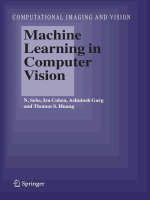

![data mining and machine learning in cybersecurity [electronic resource]](https://media.store123doc.com/images/document/14/y/op/medium_hJlflZCPev.jpg)
